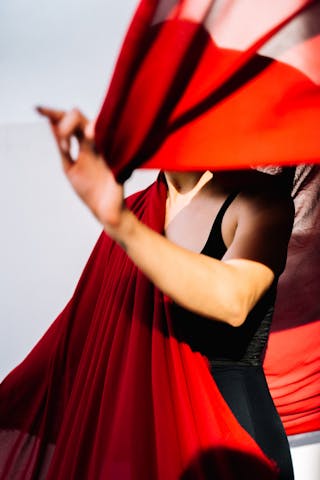Creating An Asexual Character For TV Showed Me We Have A Way To Go
Have you ever noticed the lack of representation of asexuality in TV characters? It's a long road ahead for the entertainment industry to accurately portray asexuality, but there are some shows that are starting to explore this important topic. From Bojack Horseman to Riverdale, more and more TV writers are incorporating asexuality into their storylines. It's a step in the right direction, but there's still a lot of work to be done. If you're interested in learning more about asexuality and its representation in the media, check out this article for a deeper dive into the topic.
As a writer for a dating blog, I often find myself exploring the many facets of human sexuality. From discussing the intricacies of different sexual orientations to delving into the world of casual encounters, I strive to provide my readers with a comprehensive understanding of the diverse ways in which people experience attraction and intimacy. Recently, I had the opportunity to watch a TV show that featured an asexual character, and it opened my eyes to the fact that we still have a long way to go in terms of representing asexuality in mainstream media.
If you're looking to explore intense passion and unleash your inner desires, try out some rough sex ideas from Swingfields and take your sexual experiences to the next level.
The Lack of Asexual Representation
Explore the intriguing world of BDSM dungeons and discover a new and exciting side of your sexuality.
For far too long, the media has largely ignored the existence of asexuality. While there has been progress in recent years with the inclusion of LGBTQ+ characters in TV shows and movies, asexuality is still a widely overlooked and misunderstood sexual orientation. This lack of representation can have damaging effects on asexual individuals, who may feel invisible and marginalized in a society that often equates sexuality with identity.
Discover honest reviews of Hookup Hotshot and see if it's the right fit for you.
The Importance of Asexual Representation
The inclusion of asexual characters in mainstream media is crucial for several reasons. Firstly, it helps to raise awareness and promote understanding of asexuality among the general public. By seeing asexual characters on screen, viewers can gain insight into the experiences and challenges faced by asexual individuals, ultimately fostering empathy and acceptance.
Furthermore, asexual representation in the media can provide validation and affirmation for asexual individuals, who may struggle to find relatable role models in popular culture. Seeing themselves reflected in the characters they watch can offer a sense of belonging and empowerment, reinforcing the idea that asexuality is a valid and legitimate sexual orientation.
The Impact of Stereotypes and Misconceptions
One of the biggest obstacles to asexual representation in the media is the prevalence of stereotypes and misconceptions surrounding asexuality. Asexuality is often misunderstood as a lack of sexual desire or a psychological disorder, when in reality, it is simply a variation of human sexuality characterized by a lack of sexual attraction. By perpetuating these misconceptions, the media further alienates asexual individuals and perpetuates harmful stereotypes.
Creating an Asexual Character
In the TV show I watched, the asexual character was portrayed as quirky, aloof, and socially awkward, perpetuating the stereotype that asexual individuals are inherently odd or eccentric. While it is commendable that the show attempted to include an asexual character, the portrayal ultimately fell short of providing an accurate and nuanced representation of asexuality.
Moving Forward
In order to improve asexual representation in the media, it is essential for writers, producers, and creators to consult with asexual individuals and advocacy groups to ensure that asexual characters are portrayed authentically and respectfully. Additionally, it is important to challenge and debunk the misconceptions and stereotypes surrounding asexuality, and to highlight the diversity and complexity of asexual experiences.
As a writer for a dating blog, I am committed to amplifying the voices of asexual individuals and promoting greater visibility and understanding of asexuality. By shining a spotlight on the need for improved asexual representation in the media, I hope to spark meaningful conversations and drive positive change within the entertainment industry.
In conclusion, creating an asexual character for a TV show showed me that we still have a long way to go in terms of accurately representing asexuality in mainstream media. By challenging stereotypes, consulting with asexual individuals, and promoting greater awareness, we can work towards a future where asexual representation is not only present, but celebrated and respected.
- https://dating.campsupernow.com/posts/best-lelo-sex-toys/
- https://fuck-apps.timebombrecordings.com/posts/
- https://chat.themountaintopplay.com/posts/why-is-dating-sunday-the-busiest-day-on-dating-apps-in-2024/
- https://hookupguide.ua-sex.com/posts/ditching-the-dating-apps-can-we-still-find-love-irl/
- https://online-sex.timebombrecordings.com/posts/the-19-best-bondara-sex-toys-for-2024/
- https://dating-website.getweps.com/posts/15-signs-the-guy-youre-dating-isnt-the-woke-bae-he-thinks-he-is/
- https://dating-app.timebombrecordings.com/posts/haunting-is-the-newest-dating-trend-youve-definitely-encountered-what-is-haunting/
- https://dating-website.getweps.com/posts/kristen-stewart-on-the-huge-responsibility-she-felt-to-define-her-sexuality/
- https://dating-app.thehottieandthenottie.com/posts/luxury-sex-toys-high-end-sex-toys/
- https://datingguide.timebombrecordings.com/posts/why-friend-breakups-are-the-worst-ending-a-friendship/
- https://chat.campsupernow.com/posts/sexual-inexperience-men-on-makes-women-experienced-in-bed/
- https://free-dating-website.thehottieandthenottie.com/posts/i-tried-the-tiktokfamous-rose-sex-toy/
- https://flirting-online.ua-sex.com/posts/cat-person-film-shows-why-women-have-charity-sex-with-men/
- https://dating-for-free.fu-direct.net/posts/dating-tips-from-the-1930s-that-still-apply-to-millennials/
